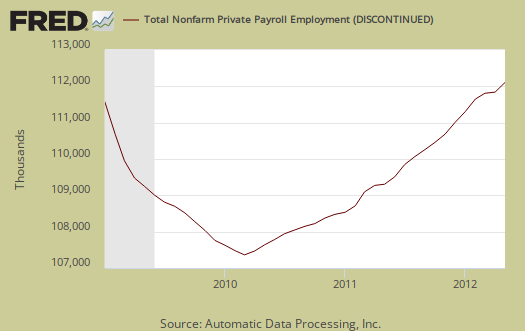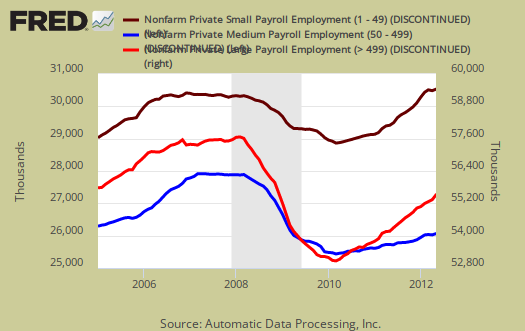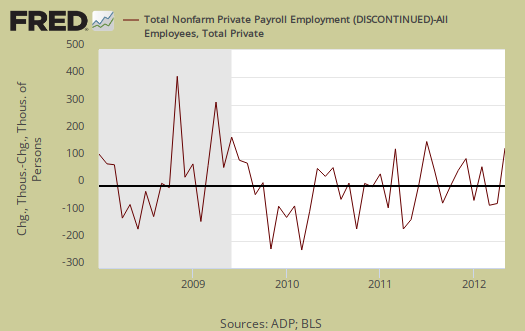ADP, released their proprietary private payrolls jobs report. This month ADP is reporting a gain of 133,000 private sector jobs in May. April 2012 was revised down by 6,000, from 119,000 to 113,000. In contrast, the BLS reported 130,000 private sector jobs for April 2012. Graphed below are the reported private sector jobs from ADP. This report does not include government, or public jobs. If the ADP mirrors the BLS report tomorrow, this would be yet another weak jobs report.

Almost all of ADP's private job growth was in the service sector, which gained 132,000 jobs. The goods sector only gained 1,000 jobs. Manufacturing, part of the goods sector, lost 2,000 jobs and was the 2nd month in a row to lose manufacturing jobs. Construction also lost 1,000 jobs, also the 2nd month in a row. ADP's financial services jobs increased by 8,000 jobs, the 10th month in a row for private payroll increases for the financial sector.
This report, if it matches Friday's official unemployment report, would overall imply really weak job growth. Odds on there will be more government job losses and the U.S. needs about 100,000 jobs per month just to keep up with population growth.
ADP captures jobs by business size and this is worth looking at, especially due to it's relativity within the same report (and methods). In May:
Employment on large payrolls—those with 500 or more workers—increased 9,000 and employment on medium payrolls—those with 50 to 499 workers—rose 57,000 in May. Employment on small payrolls—those with up to 49 workers—rose 67,000 that same period. Of the 57,000 jobs created by medium-sized payrolls, 2,000 jobs were created by the goods-producing sector and 55,000 jobs were created by the service-providing sector.
Below is the graph of ADP private sector job creation breakdown of large businesses (bright red), median business (blue) and small business (maroon). For large business jobs, the scale is on the right of the graph. Medium and Small businesses' scale is on the left.

Large business, who lobby Congress for their bad trade deals, more offshore outsourcing through foreign guest worker importation and labor arbitrage, are almost absent from job creation in terms of hiring Americans. Notice how large businesses cliff dove in 2008, shedding employees, and have not returned at all to pre-recession employment levels. This pattern actually starts just about the time offshore outsourcing and the China PNTR came into effect, year 2000. Small businesses, on the other hand, have increased employment. May I suggest that small businesses are not international, they are not signing offshore outsourcing contracts and moving jobs to India and China. Multinationals, on the other hand, the below decade trend line clearly shows these so called U.S. corporations have abandoned the U.S. worker, on whole.
There is a historic strong mismatch between ADP and the BLS jobs report, although recently the two are converging again recently. To date, the number of private nonfarm payroll jobs ADP reports versus what the BLS reports and on a month-to-month and even cumulative basis do not match. This monthly error is often large, especially when looking at small job growth overall (< 400,000 jobs per month) on a month to month basis. The monthly BLS jobs survey (CES) has a 100,000 payroll jobs overall margin of error.
The below graph shows shows how many private sector payroll jobs, each month, ADP was off by in comparison to what the BLS reported. This is a monthly graph, not cumulative. As we can see, it's rare where the two monthly reports get the exact same private payrolls growth numbers and April was off by 17,000 jobs. When the below graph number is negative, that means the BLS reported a larger number of jobs than ADP did, when the graph bar is positive, it means ADP reported larger private payrolls. Again, these are private sector jobs which is different from the BLS headline number. This graph was updated with the May BLS jobs report.

Below is the cumulative difference between what the ADP reports as the private nonfarm payroll jobs vs. the BLS (ADP minus BLS). This line shows the divergence, over time in number of nonfarm private payroll jobs reported between the two reports. The difference seems to be stabilizing around 400,000. This article was updated with the May BLS payrolls data.

While ADP notes a simple correlation of 0.95, well, a 5% error between monthly reported jobs numbers is an average, and we can see on some months the differences are quite large and around 2008, the difference started to hit about 900,000 jobs. That said, the reported job growth is so piss pour, statistically we're rolling around in the margin of error each month.
ADP does use the same seasonal adjustment as the BLS, but their other methodology and even sampling size are different, proprietary. That said, ADP has now put up some details of their methodology to explain the statistical differences between their estimate, the actual mathematics, vs. the BLS. This is new, and good ADP is disclosing their entire methodology so we may get more apples to apples comparisons of the two reports. The graph below is the monthly change of private jobs as reported by ADP.

Regardless of the statistical differences between ADP and the BLS, May's report indicates a return to poor job growth. Sorry folks, 100k job growth numbers does not mean the Gods are now shining upon us. More we're all simply used to seeing beyond belief, pathetic job growth numbers. We still have estimated 28 million people needing a job. Four Hundred thousand monthly job growth, on the other hand, would be something to sing hallelujah over.
Here is last month's ADP private sector jobs report overview, only graphs revised.

This decimation of middle and working class destroys societies
There is no society, none, in history, that could keep this up for long. You cannot have highly educated people with skills in all industries literally begging for paying jobs and getting nothings for years on end. When these people who have so much to offer are purposely ignored by "American" (in name only) companies and their puppets in government to cut costs and enrich themselves, you are creating an army of pissed off people who used to buy into the American Dream. You cannot have people who could design and produce tens of thousands of different products going from highly motivated and being the foundations of their towns and cities (morally and financially) into facing homelessness. People obtained all the necessary education, often at great personal cost and financial burdens, so that they could be extremely productive citizens in everything from medicine to engineering to aeronautics, physics, law, the military, and everything under the sun. Sidelining literally tens of millions of these people for months and years starting in their 20s on only breeds hate and despair. How can a society last when the vast majority of its citizens are angry and desperate and ignored by anyone in power who helped put them in those desperate straits? Answer: it cannot and will not unless these ostriches pull their heads out of the sand and realize not every one of them will be able to board the last chopper out of Saigon.
-Kurtz